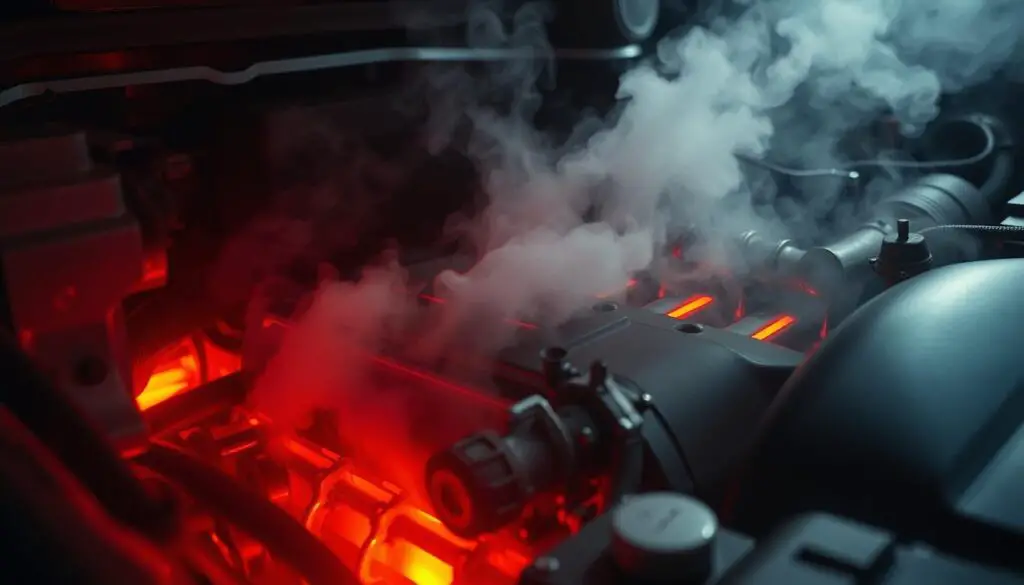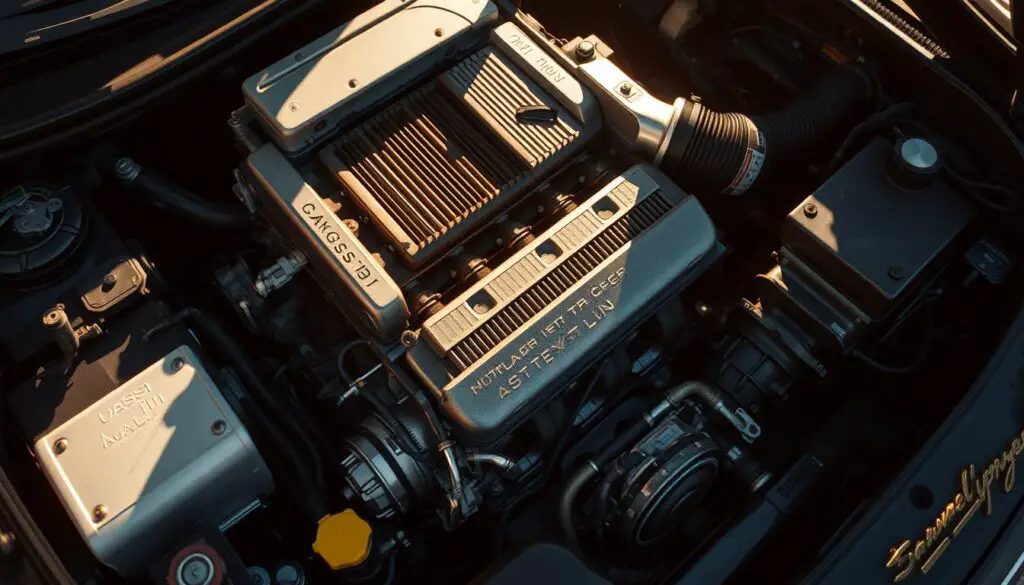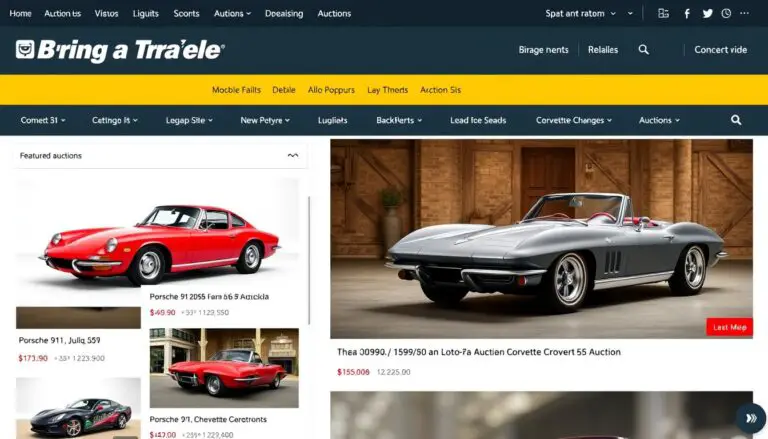Stay safe first. An overheated car demands calm, clear steps. Most guides advise waiting at least 30 minutes before any inspection.
Actual cool-down time varies with ambient temperature, recent driving, and engine size. In many cases, a wait of 60–120 minutes is safer before opening a pressurized radiator cap. Never remove a hot cap or pour cold water on hot metal.
The goal here is simple: spot warning signs, let the engine cool, then follow safe checks. You will learn roadside actions, how to tell when the system is depressurized, and basic coolant and reservoir checks. Patience cuts the risk of burns and extra damage.
Key Takeaways
- Wait at least 30 minutes; 60–120 minutes is safer before touching pressurized parts.
- Turn off A/C and use cabin heat to draw heat away if safe to do so.
- Never open a hot radiator cap or spray cold water on hot components.
- Check the coolant reservoir and look for leaks only once the temperature has dropped.
- Temporary 50/50 coolant-water top-ups may help reach service, but schedule real repairs promptly.
Recognize an Overheating Engine and Act Safely
A quick check of your dash and surroundings can stop a small problem from getting worse. Watch the dashboard warning light and the temperature gauge. If the needle moves toward red or the warning lamp glows, treat this as an urgent sign.

Visible signs and smells
Steam from the grille or under the hood usually means hot coolant, not combustion smoke. A sweet, syrupy smell often signals leaking coolant. Burnt oil odors suggest a different issue and need prompt attention.
Immediate moves that reduce heat
- Turn off the air conditioning and open windows for fresh air.
- Switch the heater to high to draw heat away from the motor if safe.
- Drive slowly to a safe stop, avoid steep hills, and keep hazards on.
Modern car controls and fans can mask early symptoms, so make sure you know where the normal gauge sits. Continued red-zone readings mean you must stop; driving on risks serious damage and costly repairs.
How Long Does It Take for Engine to Cool Down?
A vehicle that just towed a load or idled in traffic will need more minutes before checks. Start with a minimum wait so you avoid burns and sudden steam release.
Quick answer
At least 30 minutes before a basic inspection. For opening a radiator cap, wait 60–120 minutes so pressure falls and steam risk drops.

When to check coolant
The most accurate reservoir readings often come after 3–5 hours. Hot coolant expands and can give a false high mark. Waiting lets the system contract and shows true levels.
Present conditions matter
High ambient heat, towing, mountain driving, heavy stop‑and‑go, or a large displacement motor all extend cool times. Electric fans may run after shutdown, which helps but does not replace waiting.
- Feel plastic parts gently before touching metal, but do not skip elapsed minutes.
- If unsure, delay opening the reservoir until cool and depressurized.
Patience protects hands and components. When in doubt, wait longer — safety beats speed every time.
Immediate Steps: Let the Engine Cool Without Causing Damage
If your dash warns of overheating, stop safely and begin basic cooling steps right away.
Pull over at the earliest safe spot, switch on hazard lights, and move the car away from traffic if possible. Shut off the engine and get passengers to a safe distance.
Open the hood only after steam subsides. This improves airflow and helps the engine cool. Keep hands and face clear of any steam vents.
Reduce load and move heat away
Turn off the air conditioning to lower stress on the motor. If safe, run the cabin heat on high to draw hot air into the passenger compartment and away from the radiator.
Strict warnings to avoid damage
Do not remove a hot radiator cap or expansion tank cap. The system is pressurized and can spray scalding coolant.
Never pour cold water into a hot radiator or onto hot metal. Rapid temperature change may crack parts and worsen the problem.
| Action | When | Why | Note |
|---|---|---|---|
| Pull over & hazards | Immediately | Keep people safe and stop further stress on the engine | Move away from traffic |
| Wait with hood closed | 30+ minutes | Let pressure drop and steam stop before opening | Check for leaks from a distance |
| Turn off A/C, run heat | After shutdown | Draws heat from the engine into the cabin | May help engine cool faster |
Make sure you watch for any puddles under the vehicle while waiting. Some electric fans may run even with the ignition off; keep clear of moving parts. These steps reduce risk and prepare the car for later checks of system pressure and coolant.
Key Factors That Influence Cooling Time
Several factors change how quickly a hot car returns to safe temperatures. These determine how long you should wait before any inspection or work.
Outside heat, airflow, and vehicle speed
High ambient heat and little airflow slow the cooling process, especially after stop‑and‑go traffic or idling.
A moving vehicle pushes air through the radiator fins. Clean, fast airflow helps the engine shed heat faster.
Coolant level, cap integrity, and pressure
Low coolant or wrong mixture reduces heat absorption and lengthens recovery time. Keep the reservoir at the proper mark.
A worn radiator cap can leak pressure. Lower system pressure cuts the boiling point and hurts cooling performance.
Oil, water pump, thermostat, and fans
Proper oil level and condition help control heat by lowering friction and carrying warmth away from key parts.
A failing water pump, stuck thermostat, or broken fan limits circulation and forces longer cool‑off periods. Debris on the radiator or condenser also blocks airflow and delays results.
| Factor | Effect on cool‑off | Action |
|---|---|---|
| Ambient temperature & airflow | High temp and low airflow = slower cool | Park shaded; avoid hot idling |
| Coolant level & mixture | Low or wrong mix = reduced heat transfer | Check and top with correct mixture |
| Radiator cap & pressure | Bad cap = lower boiling point, loss of efficiency | Replace faulty cap; maintain seals |
| Pumps, thermostat, fans | Failures extend hot periods and risk damage | Inspect belts, pumps, and electric fans regularly |
Fixing weak parts and keeping fluids right shortens cool times and cuts repeat incidents.
Safe Handling of the Radiator Cap and Cooling System
Verify pressure before any service. Gently squeeze the upper radiator hose while holding a thick cloth over it. A firm hose means the system stays pressurized; wait longer before any work.
Only open the cap when the system feels soft and cool. Typical waits are 60–120 minutes after shutdown, but allow more time if the car ran hard or ambient heat is high.
- Use gloves and eye protection when handling the cooling system.
- If the hose softens, cover the radiator cap with a towel, push down, and turn slowly to the first detent to vent residual pressure.
- Remove the cap only after full venting and when no steam is visible.
- Never add cold water to a warm or hot system; thermal shock can crack the radiator or blockages may worsen.
Inspect the cap seal and spring while cooled. A worn cap lowers pressure and can cause repeat overheating. Some cars use a remote expansion tank—follow the owner’s manual for the correct service point.
| Check | Method | When | Why |
|---|---|---|---|
| Upper hose pressure | Squeeze with cloth | Before touching cap | Detects residual system pressure |
| Cap venting | Towel, press, turn to detent | After full cool | Releases trapped pressure safely |
| Cap condition | Inspect seal & spring | When cool | Prevents poor pressure control |
| Coolant handling | No cold water on hot parts | Always | Avoids thermal shock and cracks |
Post‑Cool Checks: Temperature Gauge, Coolant Levels, and Leaks
When the dash needle returns near normal, perform basic checks on hoses, reservoir, and radiator. Restart only after the system feels calm and fans have stopped.
Reading the gauge after restart
Watch the temperature gauge as the car warms. Let the needle stabilize near the normal mark before driving on. If the gauge climbs into red, shut down and wait again.
Checking reservoir and radiator
Inspect the translucent reservoir against MIN and FULL lines when fully cool. If safe, lift the radiator neck and check fluid level. Hot expansion can hide low levels, so longer waits give a truer reading.
Spotting leaks and component issues
Look under the vehicle for fresh fluid puddles in green, orange, pink, or yellow shades and note any sweet smell. Check hoses, clamps, and fan blades for residue or damage.
“If overheating repeats or fluid drops fast, schedule professional service right away.”
Temporary top‑up
If needed, add a 50/50 coolant-water mix slowly and secure caps before restarting. Use plain water only as an emergency short‑term fix to reach a shop.
| Check | Action | Sign |
|---|---|---|
| Temperature gauge | Watch until stable | Normal needle = safe drive |
| Reservoir level | Compare MIN/FULL when cool | Below MIN = top up |
| Under-car inspection | Scan for colored puddles | Fresh drip = leak |
| Hoses & fan | Check clamps, cracks, spinning | Damage or failure = shop visit |
Preventing Overheating: Maintenance and Driving Habits
Routine attention to fluids and belts stops many common cooling failures before they start.
Monitor coolant and oil levels at regular intervals and before long trips. Low fluid hides problems and raises temperature risk. Schedule a cooling system flush near 40,000 miles to remove scale and restore heat transfer.
Inspect critical parts regularly
Check the radiator fins for debris and clean gently. Look over hoses for cracks, bulges, or worn clamps. Verify the thermostat and water pump operate correctly and confirm fan belts and electric fans run when needed.
Smart driving in heat
Ease up on aggressive acceleration and minimize stop‑start traffic when possible. Reduce A/C use during steep climbs or heavy congestion if the dashboard gauge begins to rise. Park in shade and use sun screens to lower cabin and under‑hood heat soak.
Practical readiness
Keep spare coolant and basic tools in the trunk. A small top‑up after the car has cooled can get you to a service center. Make sure routine car maintenance is current to reduce costly failures and extend vehicle life.
| Preventive Step | Interval / When | Benefit |
|---|---|---|
| Coolant level check | Monthly and pre‑trip | Avoids low coolant surprises |
| Cooling system flush | ~40,000 miles | Removes scale; improves heat transfer |
| Radiator & hose inspection | Every oil change | Detects leaks and weak parts early |
| Fan belts & electric fans | Annually or at first sign | Prevents sudden cooling failure |
Common Mistakes to Avoid That Prolong Cooling
Simple errors when handling a hot cooling system can cause severe burns and costly repairs. Stay calm and follow a safe process while the car and engine cool.
Removing the radiator cap while hot
Do not remove radiator cap when the system is hot. Trapped pressure can eject scalding steam and fluid toward your face and eye. Trying to remove radiator cap early risks serious burns and extra damage.
Pouring cold water onto a hot engine
Never pour cold water onto hot metal or into a hot radiator. Thermal shock can crack metal or plastic parts and make an overheated engine worse. That mistake often turns a simple roadside stop into expensive repairs.
- Patience pays: wait until hoses feel soft and any hissing stops.
- Use protection: gloves and a towel when you vent and then open the cap slowly.
- Keep water ready only for mixing with coolant after full cool‑down, not for emergency dousing.
- Avoid forcing stuck parts: rushing often doubles damage and repair time.
Take your time; a careful process preserves the car and keeps you safe at the roadside.
Conclusion
A steady process — stop, wait, inspect — keeps you safe and helps spot real problems early.
Wait at least 30 minutes before any checks, 60–120 minutes before opening the radiator cap, and up to 3–5 hours for the truest coolant level reading. These windows cut the risk of burns and further engine damage.
Do not open a hot cap or pour cold water on hot parts. After a careful wait, check reservoir levels, scan for leaks, then restart and watch the gauge and temperature closely.
Keep routine maintenance like coolant flushes, hose and radiator inspections current. With patience and the right steps, most roadside overheating events are manageable and end with minimal repairs.
FAQ
What signs indicate an overheating vehicle and require immediate action?
Dashboard warning lights and a temperature gauge in the red are the first clear signals. Visible steam from under the hood, a sweet, syrupy smell from coolant, and loss of power or rough idling are also common signs. Pull over safely, turn on hazards, and stop the engine as soon as possible.
How soon is it okay to touch the radiator cap after the car has overheated?
Never open the radiator cap while the system is hot and pressurized. Wait at least 30 minutes; 60–120 minutes is safer. For high ambient temperatures or after hard driving, consider waiting 3–5 hours. Always use a thick towel and a slow-turning two-stage release once the system is cold to the touch.
When should I check coolant levels after an overheating episode?
Only inspect the coolant reservoir and radiator once the engine and cooling system are cool. Check the translucent overflow bottle first; if levels are low, top up with the correct mix of coolant and water. If you must add fluid on the road, use engine-temperature-appropriate precautions and add slowly to the reservoir rather than the radiator neck.
Can running the cabin heater help reduce underhood temperature?
Yes. Turning off the air conditioning and switching the heater to maximum can pull heat from the engine into the cabin, speeding cooldown. Do this only after safely pulling over and with the engine running briefly if needed; avoid extended idling in unsafe locations.
What external conditions change how fast a vehicle cools?
Ambient temperature, wind, and vehicle speed matter. On a cool, windy day or while driving slowly with airflow through the grille, the engine sheds heat faster. Hot weather, stalled traffic, and large engines retain heat much longer and require extended cooling time.
How do coolant level and radiator cap condition affect cooldown time?
Low coolant slows heat transfer and lengthens cooldown. A faulty radiator cap can fail to hold pressure, alter boiling point, and reduce cooling efficiency. Proper coolant concentration and a serviceable cap help maintain correct system pressure and faster, safer cooling.
Are oil condition, water pump, thermostat, or fans important for cooling speed?
Yes. Engine oil that’s low or degraded reduces internal heat control. A failing water pump or stuck thermostat blocks coolant flow. Electric or mechanical fan failures reduce airflow when stationary. Any of these issues can dramatically increase cooling time and risk damage.
What is a safe method to check pressure before removing a cap?
Squeeze the upper radiator hose to feel for pressure once the engine is warm. If it’s hard, the system remains pressurized—do not open the cap. Only attempt a cap release when hoses are soft and cool. Use gloves or a towel and lift the cap slightly to relieve trapped pressure in a controlled way.
How should I remove the radiator cap once the system is cool?
Place a thick glove or towel over the cap, press down, and turn slowly to the first stop to bleed off any remaining pressure. Wait a few seconds, then fully remove. If you see sudden steam or hear hissing, stop and wait longer. Never force the cap off.
What should I look for after cooling before driving again?
Check the temperature gauge for stable, normal reading. Inspect the coolant reservoir and radiator for proper level and visible leaks. Look for dried coolant residue, swollen hoses, and damaged fan blades. If any damage, leaks, or recurring overheating appear, tow the vehicle or seek professional repair.
Is it okay to top up coolant temporarily to reach a service shop?
Yes, a temporary top‑up is acceptable to reach a repair location. Use the correct coolant type or a 50/50 mix with clean water if needed. Add to the reservoir first; avoid pouring cold fluid directly into a hot radiator. Drive gently and monitor the gauge.
What routine maintenance prevents overheating and long cooldowns?
Regularly check coolant and oil levels, replace coolant per manufacturer schedule, inspect hoses, belts, thermostat, water pump, and radiator cap. Clean debris from the radiator and confirm fan operation. Good maintenance keeps the cooling system efficient and reduces the risk of severe overheating.
What common errors prolong cooling or cause extra damage?
Removing the radiator cap while hot and pouring cold water on a hot engine both risk warping heads, cracking the block, or causing scalding steam. Driving aggressively while the vehicle is overheating can also worsen damage. Always follow safe cooling steps and seek professional help if unsure.


